Designing the Hidden, Hiding the Obvious
Assistant is an international and interdisciplinary design practice co-founded by Megumi Matsubara, Hiroi Ariyama and a team of others. This June at their studio-cum-gallery space, “gallery within assistant”, Megumi Matsubara pieced together a series of explorations into an installation titled “Absent City.” The multimedia interactive installation combined photography, sound, interior design and architectural-model-influenced sculpture in an environment that allowed viewers to develop their own non-linear fictions. While the installation was planned and produced by Matsubara, the number of participants and collaborators involved created a fragmented and networked creation rather than a grand master narrative.
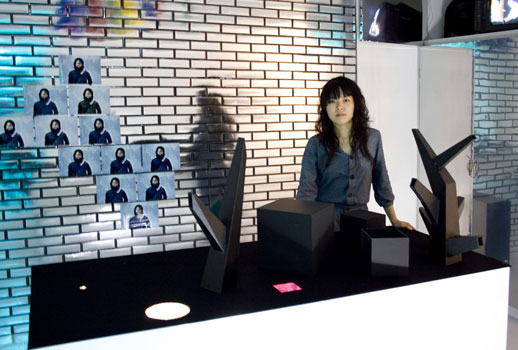
Upon entering the gallery visitors donned headphones with a radio receiving localized broadcasts of conversations associated with portraits of people scattered throughout the room. Moving between images and transmission ranges, listeners were confronted with static, the noise of urban life, before the next moment of clarity emerged. Occasionally a soundtrack played over gallery speakers intruded between conversations and static. The crystal-clear portraits had a shallow depth of field blurring their vaguely urban backgrounds in a milky haze. In the center of the room black felt covered a table bedecked with various black objects: cubes, polyhedra, abstracted tree shapes. Cutouts appearing in the fabric permitted small glimpses of mysterious objects and ‘landscapes’ within the diorama-like construction.
This contrast of clarity and obfuscation pervaded the installation as well as the process by which Matsubara produced the work. There were people shadowed, arcane references, personal narratives, and non-literal translations attempting to encompass wider meaning. Specificity confronted the obscure. Personal narrative coupled with reader interpretation. Simultaneity challenged sequence, fiction mimicked documentation, and interviews became music. All combined in a cocktail of media and ideas that eluded the singular in favor of multiple sensory experiences.
There are a lot of ideas and means of expression here. How did this start?
It’s always me working in collaboration with others, so I booked lunches called “Sociological Lunch” in February starting from Monday with Ega and ending with Yoshi on Sunday, at seven different places in Tokyo. I gathered some materials from the area, recorded our conversations and took film footage. I also had two or three kinds of secret agent-like people around us, unknown to the person I was having lunch with. In Yoshi’s case it was different because it was in his house, but in other cases it was at restaurants and cafes and it was easy. They were sitting right next to us secretly and they were documenting our lunch and listening to our conversation.
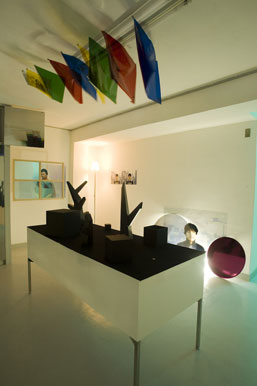
After those “Sociological Lunches” together with Hiroi, we made a map of Tokyo’s cityscape based only on my memory of the conversations and the things we talked about…all those bits of images inside my head. You can call it a psychological map because it had no physical measurement. It was only based on images and memory.
This is a coffee table that has a model inside. [Matsubara points to the black felt-covered table in the center of the room.] But also this is a coffee table where you can sit down and have coffee and conversation and “Sociological Lunch”: a 90-minute lunch with a 90-minute discussion with someone and a 90-minute soundtrack. So in a way I wanted to confuse the scale of things as well. There are so many tiny pieces, and there’s no big structure. It is layered information that is being multiplied. Some are growing, spreading. Some are even moving. It’s like particles, movement, but together creating some kind of whole: an impression of the universe but one in which there is no visible overview. You can only see inside through filters and view ports located at certain points. Sometimes things are clear, while sometimes there is nothing there.
How are the conversations and images related here? Or, how do we read this?
You can only see through these small perceptual filters, but it does spread all around inside this table and it consists of very tiny pieces. You can see [lifts the black felt cover revealing the table interior]
You’re giving away the secret.
Different areas are based on different people’s keywords. There is some wind inside the model; you can see some stuff blowing around. And there are many small keywords in Japanese that you can see installed inside.
Are these keywords arbitrary, contextual, such as from the conversations, or concepts you chose to explore?
The keywords are extracted from books, vintage books, newspapers or magazines from vernacular sources in the area. Just before the lunch I took a copy from the nearest bookstore, convenience store or wherever available. I handed that to one of the “secret agents”. Then this person had to map by listening secretly to our conversation and find some kind of similarity or something that could be imagined from our conversation. They had to mark that down as key phrases or numbers, or something else if they wanted. So these keywords are not the phrases these people actually said but words filtered through somebody.
Assistant is a team and together we made this model, but at the same time only I know the memory and the images of these people. So in a way it’s an open process and I consult with them sometimes. For the most part we have to be together and create together.
It’s not a literal model but a psychological model.
Yeah. You have to translate these words or images into something different. So in the process there are so many objects that have been thrown away because it was difficult for the team to understand what would and wouldn’t work.
Does it become an archive of this point in time in your process?
Yeah, it’s a packaging of a certain time. Maybe it’s not a Pandora’s box, but when you open it and see it you think it’s so many things. It’s quite confusing. When I see it, even though I know how I made it, suddenly I start remembering a few conversations that I almost forgot, but by looking at this model they come back to me. They grow again. Those kinds of processes or those kinds of reactions are the triggers of feelings, experience and memory. And that’s something I really wanted to recreate.
Are you influenced by the Situationists?
I first heard about them in graduate school when I made a conceptual project for a mobile phone application. It was more than five years ago right after GPS technology was installed in phones. There were only very simple functions and simple applications available, but I was very excited by them. Together with some programmers I made a project called “Happy City” using GPS-installed internet-connectable mobile phones. You could actually press a button from where you are happy and then see the psychological thermometer of the whole city, of the whole of Tokyo. An architecture and urbanism critic saw that project and told me about the Situationists and Guy Debord. They are a very interesting group of people, but I’m not always influenced by them.
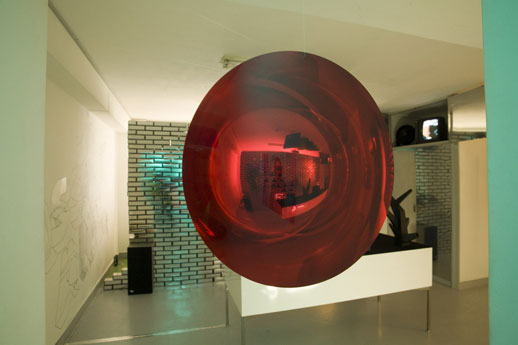
There are a lot of affinities to psychological mapping, the “Naked City”1 and temporary autonomous events throughout the city.
Yeah, for sure I do feel more sympathetic to their way of thinking and extracting impressions, extracting feeling instead of just what you see. Quite often architects tend to forget that their work is based on experience. Everything is there to be experienced, not just taken from a visual point of view alone.
How would you describe your idea of urbanism, architecture, and space in general?
I don’t know if I have an idea of such things in general. I think the only thing I can say is that my ideas are constantly changing through the projects I do. I always question what things are or could be through my projects.
What about some of the other collaborative elements? How do they fit in?
For this music [the soundtrack playing in the room] I worked with a Finnish musician, Ilpo. I sent him all the conversation recordings and asked him to make a sound environment lasting ninety minutes using only these pieces. He could distort the material however he liked; the only rules he had were that it had to be ninety minutes and it had to include all the conversations somehow. It wasn’t necessary to have to be able to hear what is being said, but all the seven sound recordings had to be in the music.
Also, this portrait series, I commissioned a photographer to take portraits of the seven people in different streets in Tokyo. The series is called “Translucent Portraits”. It’s not Photoshopped. The translucent background was created with a photo studio made of translucent material set up temporarily on the street.
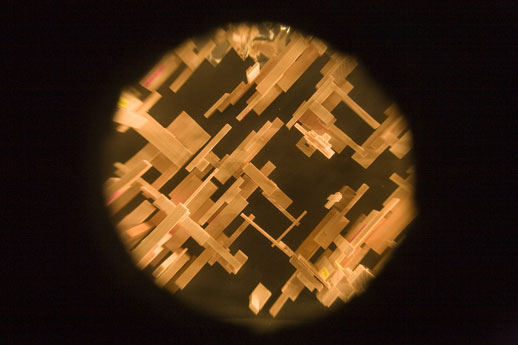
You work with a lot of different individuals. Does that grow out of assistant and working with a larger collaborative? What’s your working process?
The working process is quite diverse because the studio is not closed off to the outside world. For example this project’s conception is mine in that I created the story and I created the whole idea of the project. But at the same time I left space for the photographer, for the musician, or for other people to involve themselves and do something. So it’s an open process.
When I decided to do the portraits I needed and wanted to work with a photographer and I asked him what he thought. I respect the people I collaborate with as professionals in their respective fields and yet I bring by own ideas to the process and we discuss and negotiate what will work best. For example, in this case the photographer wanted to do a studio photo shoot, setting up a photo stage in a one room with a proper white background. But for me, that didn’t fit with my basic conception of the project, so I came up with the idea that we could shoot on the street in a temporary photo studio. I wanted to use the translucent material for that, so that it would halfway between indoors and outdoors; it had to float in the background.
With the music, I didn’t care how it would sound, but I did care about the guidelines, that it had to be ninety minutes long and it had to include seven conversations. I had worked with the musician before, so I give him the initial ideas and he responded with music. So the process is very open but at the same time very precise because it cannot be any old thing. But it’s open to process but there are many things that get thrown out if they don’t turn out right. I really like this process of making conversations with people through work… art work.
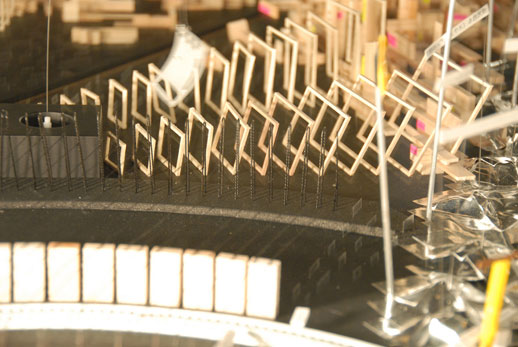
A lot of process-oriented works, as much as they may become artifacts, often raise more questions or ideas in the process. Has this done that yet? Has it raised any questions that you want to investigate next?
Yes, many! Even from the start. I wanted to talk about city. I wanted to talk about the future of Tokyo and I had those keywords, but I didn’t know how to begin from my own context. So, I had to visualize and make it specific to actually let myself talk about it. I wanted to talk about Tokyo from a very internal point of view, but that eventually turned into a layered self, which turned into cityscape.
You framed “Absent City” as a memoir. Does the installation use memoir as narrative, documentary and fiction, or precognition or fortune telling?
The installation is a combined environment that includes all layers of information from memory, to impressions, guesswork, misunderstandings, feelings, dis-communication and serendipity. Through the process of combining all layers as one space it becomes a kind of spatial memoir in which stories are perceived through the senses. This form is similar to the half-narrative, half-documentary of Marco Polo’s “Travels of Marco Polo” in which he reports his story to his master, giving him a narrative exploration.
Is this the first in a series or do you consider this a continuation?
The project started in January of this year. Back then there wasn’t a concrete idea about what it would become. But at the same time I wanted this to grow in six months time to something like an exhibition that people can actually experience. I’m sure this project will continue in different forms and grow into a bigger exhibition. But that’s not the goal. It’s the process of showing and that process itself contains results. These works are complete; they are not just works in progress.
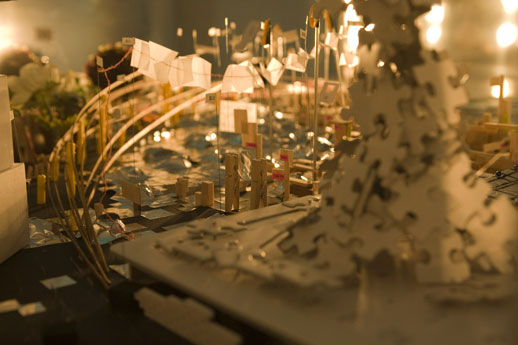
So this is the first public manifestation and exhibition. Is there a timetable that every six months you will produce something?
There isn’t a timetable. I don’t feel the need for us to have a show every six months like clockwork. The next one could turn out to be in two weeks. For all I know, by then I could have already produced something worth showing. This urban research project is continuous and throughout the project things happen. For example this started with the conversations we had at our ‘Sociological Lunches’ — they were smaller projects inside a bigger project.
For example, in February I had the conversations with seven people. In March we had a project called “Absent Café” in the Marunouchi Building commissioned by Marunouchi Art Weeks. It was an installation project, but I also had the idea that we could do an “Absent Symposium” together with the “Absent Café” installation. The conversation that was to take place inside the café was taken outside and then it was turned into an online and postcard project. There were 3000 postcards and online forms calling for people to be panelists and they could send messages to the Absent email address, people would reply, and the conversation were intended to continue until they reached a natural end. These “Absent Symposium” messages are also part of the catalog now. It did create some kind of context for the project too. It’s not like you can actually define what is part of this project and what is not. “Absent City” just grew. It’s like sowing seeds and seeing what happens.
Is this then informing a next step or project?
Well, for sure it will grow and be a component but we don’t know exactly when yet. It’s possible that in six months we’ll do something. It could be in the form of a publication or an exhibition. Some reaction to the exhibition will probably lead to some other related project and eventually we will know how to make sense of the next step. But for me its important to come up with something interesting to say about Tokyo from a different point of view. That way it will become a part of “Absent City” vision.
—
1 “Naked City” is a collage map created in the summer of 1957 by Guy Debord, a seminal member of the French literary/cultural movement Internationale Situationniste. The map records his urban psychogeographic studies and was produced through ‘détournement’ in which fragments of existing works are rearranged or juxtaposed to produce new meanings. As conventional maps represent geometric realities of the city, psychogeographic maps convey experiential impressions. The map shows large arrows connecting city map fragments where certain experiences occurred or relations existed during the derive, a walk where one is led by attractions and encounters of the area rather than purposeful destination. The title is borrowed from a 1948 American film.
—
“Absent City” is being held at Alternative Space LOOP in Seoul, Korea from August 29 to September 21, 2008.
Assistant is also exhibiting at Diesel Denim Gallery Aoyama from August 30, 2008 to February 8, 2009. Details here.
Disclaimer: Megumi Matsubara was a TABlog guest writer from 2005 to 2006. This interview was her and the author’s first meeting.
James Way
James Way



